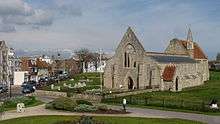70th (Sussex) Searchlight Regiment, Royal Artillery
| 70th (Sussex) Searchlight Regiment,RA 605th Heavy Anti-Aircraft Regiment, RA | |
|---|---|
|
Royal Artillery cap badge and AA patch of WWII | |
| Active | 1938–1950 |
| Country |
|
| Branch |
|
| Type | Searchlight Regiment |
| Role | Air Defence |
| Size | Regiment |
| Garrison/HQ | Brighton |
| Engagements |
Battle of Britain The Blitz |
70th (Sussex) Searchlight Regiment Royal Artillery was an air defence unit of Britain's Territorial Army (TA) raised just before the outbreak of World War II, which served as part of Anti-Aircraft Command during and after the war.
Origin

As the international situation deteriorated in the late 1930s, the threat of air raids on the UK led to the rapid expansion in numbers of anti-aircraft (AA) units manned by members of the part-time TA. Formed in November 1938, 70th (Sussex) was the first TA searchlight regiment raised by the Royal Artillery (previous TA S/L units had all been part of the Royal Engineers and/or converted from infantry battalions).[1] It consisted of HQ and Nos 459–461 Companies (later Batteries) based at High Croft, Dyke Road, in Brighton (now Quebec Barracks of the Army Reserve).[2][3] It was equipped with the new '90 cm Projector Anti Aircraft', a smaller and lighter piece of equipment than previous searchlights, with a more powerful high current density arc lamp with automatic carbon feed.[1][4][5][6]
World War II

Anti-Aircraft Command mobilised in August 1939, ahead of the declaration of war on 3 September, and the regiment took its place in 27th (Home Counties) Anti-Aircraft Brigade, part of 6th AA Division tasked with defending South East England.[7][8][9]

In 1940, 27 AA Bde transferred to 5th AA Division and moved to Portsmouth to assist in the defence of the Royal Naval Dockyards there.[10] Portsmouth was a major target for the German Luftwaffe, and the regiment was present during the daytime bombing raids of the Battle of Britain, when searchlight detachments had a subsidiary role in plotting raids and in close defence with light machine-guns.[11] Searchlights were vital for directing AA guns and night fighters during the night attacks of The Blitz (1940–41), when Portsmouth city centre was devastated by a series of raids.[12][13][14] The city was attacked again during the Baedeker Blitz of 1942.
As the threat from the Luftwaffe waned in 1944, the War Office warned in June that AA Command would have to release manpower to provide reinforcements to 21st Army Group fighting in North West Europe. The run-down began in September 1944, and 70th S/L Rgt was placed in 'suspended animation' in that month, with its personnel being posted away.[4][5][7][15]
Postwar
When the TA was reconstituted in 1947, 70th S/L Rgt was reformed at Brighton as 605 (Mobile) Heavy Anti-Aircraft Regiment, RA (Sussex), forming part of 106 AA Bde.[4][16][17][18][19] However, in June 1950 it was amalgamated into 344 (Sussex Yeomanry) Light AA/Searchlight Regiment, becoming R Bty of that regiment.[4][18]
Prominent figures
Among the first officers commissioned into the regiment on 1 November 1938 was Lieutenant (later Captain) Sir Herbert Latham, 2nd Baronet, MP. In 1941 he was court martialled and found guilty of 'improper behaviour' (homosexual acts) with three gunners and a civilian, for which he was dishonourably discharged and imprisoned.[20][21]
Notes
- 1 2 Brigstock. Archived March 4, 2016, at the Wayback Machine.
- ↑ Monthly Army List, January 1939.
- ↑ 3 PWRR at British Army website.
- 1 2 3 4 Litchfield, p. 234.
- 1 2 70 S/L Rgt at RA 39–35.
- ↑ Routledge, p. 55.
- 1 2 6 AA Division 1939 at British Military History.
- ↑ AA Command 3 September 1939 at Patriot Files.
- ↑ Routledge, Table LX, p. 378.
- ↑ 5 AA Division 1940 at British Military History.
- ↑ Routledge, pp. 55 & 383.
- ↑ 5 AA Division at RA 39–45. Archived March 4, 2016, at the Wayback Machine.
- ↑ Routledge, Table LXV, p. 396.
- ↑ Farndale, Annex D, p. 257.
- ↑ Routledge, pp. 420–1.
- ↑ Litchfield, Appendix 5, p. 335.
- ↑ Farndale, Annex M, p. 340.
- 1 2 592–638 Rgts RA at British Army 1945 on.
- ↑ 67–106 AA Bdes at British Army 1945 on.
- ↑ Monthly Army List, May 1939.
- ↑ Gasgow Herald 5 September 1941.
References
- Gen Sir Martin Farndale, History of the Royal Regiment of Artillery: The Years of Defeat: Europe and North Africa, 1939–1941, Woolwich: Royal Artillery Institution, 1988/London: Brasseys, 1996, ISBN 1-85753-080-2.
- Norman E.H. Litchfield, The Territorial Artillery 1908–1988 (Their Lineage, Uniforms and Badges), Nottingham: Sherwood Press, 1992, ISBN 0-9508205-2-0.
- Brig N.W. Routledge, History of the Royal Regiment of Artillery: Anti-Aircraft Artillery 1914–55, London: Royal Artillery Institution/Brassey's, 1994, ISBN 1-85753-099-3
External sources
- Keith Brigstock 'Royal Artillery Searchlights', presentation to Royal Artillery Historical Society at Larkhill, 17 January 2007.
- British Military History
- British Army units from 1945 on
- Orders of Battle at Patriot Files
- Royal Artillery 1939–1945
